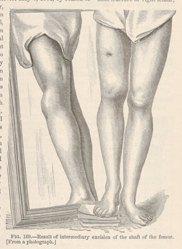Title: Kendall, J. B.
Source text: The Medical and Surgical History of the War of the Rebellion. (1861-65.), Part 3, Volume 2 (Washington, DC: Government Printing Office, 1883), 207.
Civil War Washington ID: med.d2e10127
TEI/XML: med.d2e10127.xml
CASE 419.—Private J. B. Kendall, Co. K, 5th Wisconsin, aged 34 years, was wounded in the right thigh during the assault on the heights of Fredericksburg, May 3, 1863, and entered Campbell Hospital, Washington, five days afterwards. Surgeon A. F. Sheldon, U. S. V., reported his discharge from service May 3, 1864, by reason of "shot fracture of right femur," and at an examination on July 2, 1866, Surgeon J. H. Baxter, U. S. V., described the man as "suffering from the effects of an excision of nearly five inches of the femur." On November 6, 1867, the pensioner, who then held the appointment of clerk in the Quartermaster General's Office, visited the Army Medical Museum, when the photograph, represented in the annexed cut (FIG. 169), was taken. The following information in regard to his case was elicited from his statements: "He was wounded by a musket ball, which split upon the shaft of the femur, a portion of the missile lodging in the cylinder of the bone and a portion traversing the thigh and making its exit posteriorly. He was conveyed on a stretcher to a house in Fredericksburg, and on the following morning to the Sixth Corps Hospital on Falmouth Heights. On May 10th, he was sent on the cars to Aquia Creek, and thence on a hospital transport to Washington. The injured limb was suspended by Smith's anterior splint. There was intense irritative fever, with copious suppuration. On May 21st, Acting Assistant Surgeon F. W. Kelly made a long incision on the posterior aspect of the thigh, removed a fragment of ball and numerous detached pieces of bone, and turned out and sawed off the sharp extremities of the fractured shaft. The limb was then supported in a wooden trough by cushions. The surgical fever and suppuration gradually abated, and ultimately firm union took place and the wound healed. Abscesses formed several times after his discharge from hospital, and bits of necrosed bone were eliminated. The sinuses did not close definitely until August, 1868." At the time of his visit to the Museum the cicatrices were in a sound condition, and the fracture appeared firmly consolidated, having resulted in two and a half inches shortening of the limb and false anchylosis of the knee. His general health was excellent, and, notwithstanding the stiffness of his knee, he walked briskly with only a slight limp, injury this pensioner has been exempted from examinations. The pensioner was paid December 4, 1878.
